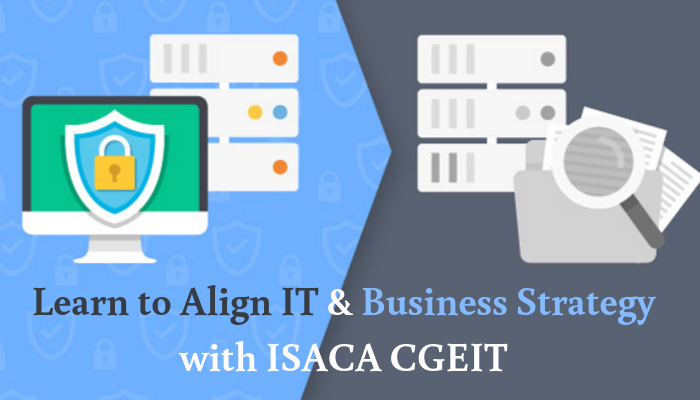The Certified in Governance of Enterprise IT -CGEIT certification, intended for IT professionals, is a vendor-neutral certification offered by the ISACA. This certification is typically for individuals who are already in management and leadership positions and looking for higher management-level positions. The CGEIT certification is a framework-agnostic certification, meaning, once achieved, it helps individuals to get into IT leadership positions for various networks.
Get Your Free Preparation Guide for ISACA CGEIT Certification
Individuals aspiring to obtain CGEIT certification require to pass only one exam – the CGEIT exam. CGEIT exam includes planning and establishing frameworks for the governance of enterprise IT, administering strategic initiatives, identifying and balancing risk, and improving the use of resources to accomplish network objectives.
What Is IT Governance?
IT governance is a method to focus on the alignment of the information technology systems of an enterprise. It concentrates on the refinement process and initiates measures to add worth to an enterprise.
IT professionals in this field who are acquainted with the concept of governance of enterprise IT are addressed as invaluable assets for an organization.
Information About ISACA CGEIT Exam
The CGEIT exam comprises 150 multiple-choice questions (MCQs), and the applicant has to answer them in four hours. There are four domains on which an applicant is examined.
ISACA CGEIT Domains
- Domain 1: Governance of Enterprise IT
- Domain 2: IT Resources
- Domain 3: Benefits Realization
- Domain 4: Risk Optimization
The CGEIT exam evaluates applicants for their skill in governing an enterprise IT network. This comprises planning and executing an enterprise governance framework to help accomplish organizational goals, stay within financial limitations, and retain an appropriate risk level.
Eligibility Requirements
CGEIT is designed for managers, executives, and senior IT professionals. A good experience is needed before an applicant becomes eligible to opt for this certification exam.
If you want to be eligible for the CGEIT exam, you must have at least five years of work experience in the associated field. Out of these five years, at least one year of experience establishing and administering a framework for IT governance is a requisite. Furthermore, the applicant must also have additional skills in at least two out of four CGEIT domains.
Besides, you should have experience fixing roles, responsibilities, and liabilities for information belongings and IT operations before you attempt the CGEIT exam. You need to own the skill to assess, manage, and oversee IT strategic techniques to make them coordinate the enterprise goals.
Benefits of CGEIT Certification
ISACA Certified in the Governance of Enterprise IT professionals is known for their skills and expertise in enhancing the strategic value they can bring to an organization. ISACA Certified in the Governance of Enterprise IT exam preparation develops the knowledge and experience needed to align IT with various business strategies and goals. It helps manage IT investments more efficiently, ensuring maximum returns on investment. These certified professionals thrive on excellence in IT operations and governance while keeping a strict eye to minimize risks and thus make them highly worthwhile for their organization. Some of the top advantages of the CGEIT Certification for IT professionals include:
- CGEIT Certification establishes an IT professional’s knowledge and validates the candidate for their skill in managing and implementing an IT governance framework in an organization. They are globally recognized for their knowledge and expertise.
- With ISACA CGEIT certification, IT professionals can further promote their enterprise governance, receive higher positions, and help land better salaries.
- CGEIT Certification qualifies IT professionals to fill the gap to help satisfy the growing need for skilled IT governance professionals.
- Individuals with CGEIT Certification are skillful in enhancing the business system as they know how to improve the awareness of IT governance in an organization.
- CGEIT Certification in your resume imparts you a distinct edge over the non-certified colleagues; thus, you stand a better opportunity during the hiring process.
- Certified in the Governance of Enterprise IT Certification is acknowledged around the world. It assures IT professionals with higher recognition in the organization they are working in. They can benefit from the resources of a global community of industry experts.
- ISACA Certified in the Governance of Enterprise IT professionals are the highest-paid professionals in the industry with better prospects of advancement in their careers.
- So, in a nutshell, achieving a CGEIT Certification is advantageous for current IT professionals and those desiring to work in the IT governance field.
Who Should Obtain ISACA CGEIT Certification?
CGEIT Certification is an internationally accepted acknowledgment for professionals who have governance-related experience. This certification is the best fit for management, advisory, or assurance professionals. This certification is appropriate for individuals who want to prove a satisfactory level of existing knowledge and expertise in the field they are working in.
This CGEIT certification is best suited for:
- IT Directors
- Audit Directors
- CIOs
- CEOs
- Compliance and Information Security Professionals
- IT Assurance Professionals
- Senior IT Managers
- Organizational Strategic Managers
- Managers handling governance, risk, and compliances
Study Resources ISACA CGEIT Exam Preparation
So, here comes the most crucial part of this blog that can guide you to become an ISACA Certified in the Governance of Enterprise IT professional in the future. The significance of this certification is immense; therefore, here is some helpful information that can help you to crack the ISACA CGEIT exam on your first try. So, here are the tips you should follow if you want to succeed in the exam.
1. Training Courses
Finding the right preparation course can be pretty challenging for an applicant. The best thing about ISACA is that it delivers training courses to individuals so that they may prepare for the exam easily. Most significantly, the courses are conducted by industry experts. So, you’d find them extremely helpful when it comes to taking the exams.
2. CGEIT Books
A CGEIT book about the certification exam is the next thing you may require to prepare thoroughly. ISACA has left no stone unturned by offering the books for this exam preparation.
3. Online Communities
Participating in online communities is useful as you can ask as many questions as you want, and the questions are answered here briefly. You can intensify your knowledge by answering the questions that some new applicants have posted.
4. CGEIT Practice Test
Learning from CGEIT books and training course isn’t sufficient to crack the exam; you ought to attempt CGEIT practice tests. Practice tests will provide the applicants with a solid understanding of what to expect in the exam. The result of practice tests will help exam-takers identify their preparation level and knowledge gaps.
Maintaining CGEIT Certification
ISACA certifications remains valid for three years. To keep the certification, you must undergo several continuing professional education (CPE) hours per year. CGEIT holders must keep themselves up to date in the field and obtain and report to ISACA a minimum of 20 CPE hours per year, with 120 CPE credits in three years. These CPE credits need to be acquired from IT governance-related tasks. Furthermore, you must pay annual maintenance fees and adhere to the code of professional ethics from ISACA.
The ultimate goal of the continuing professional education policy is to help the applicants to ensure that they retain an adequate level of current knowledge and proficiency in their field. This process establishes to the stakeholders that your skills and knowledge are updated and the most relevant to the present scenario.




